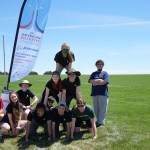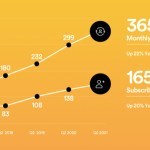Dominique Luchart's Blog, page 555
July 28, 2021
We could hunt gravitational waves on the moon if this wild idea takes off, ,

Humanity’s return to the moon could open up new windows on the universe.
NASA is working to establish a permanent human presence on and around the moon by the end of the 2020s, via a program known as Artemis. That presence may eventually include radio telescopes on the moon’s exceptionally quiet far side — and, perhaps, even more ambitious off-Earth science facilities.
For example, a recent study makes the case for building a gravitational-wave observatory on the moon.
Hunting gravitational waves: The LIGO laser interferometer project in photos
Gravitational waves are ripples in space-time created by the acceleration of massive objects. They were predicted by Albert Einstein’s general theory of relativity in 1915 and first directly detected a century later, by the Laser Interferometer Gravitational-Wave Observatory (LIGO) consortium.
LIGO has detectors at two sites, one in Louisiana and one in Washington state. Each detector is an L-shaped structure with arms 2.5 miles (4 kilometers) long, with a laser at the center of the array. The laser shines light down each arm, and mirrors reflect the light back. If the light from one arm comes back a bit late, it’s evidence of a possible gravitational-wave-induced distortion.
The LIGO team has detected dozens of gravitational-wave events to date, most of them caused by mergers between two black holes. But this is exacting work, and our noisy, active Earth makes spotting signals tough.
The moon, on the other hand, is an exceptionally quiet place, the new study notes.
“The moon offers an ideal backdrop for the ultimate gravitational wave observatory, since it lacks an atmosphere and noticeable seismic noise, which we must mitigate at great cost for laser interferometers on Earth,” co-author Avi Loeb, an astronomer at Harvard University, said in a statement.
“A lunar observatory would provide unprecedented sensitivity for discovering sources that we do not anticipate and that could inform us of new physics,” Loeb said. “GLOC could be the jewel in the crown of science on the surface of the moon.”
Lunar timeline: Humanity’s explorations of the moon
“GLOC” is short for the Gravitational-wave Lunar Observatory for Cosmology, the name Loeb and study lead author Karan Jani propose for the moon facility. GLOC would be huge compared to LIGO and other detectors on Earth, featuring arms 25 miles (40 km) long. And it would be incredibly sensitive, capable of spotting gravitational-wave events in nearly 70% of the observable volume of the universe, the researchers calculated.
“By tapping into the natural conditions on the moon, we showed that one of the most challenging spectrum of gravitational waves can be measured better from the lunar surface, which so far seems impossible from Earth or space,” Jani, an astrophysicist at Vanderbilt University in Tennessee, said in the same statement.
GLOC is just an idea at the moment, but Jani and Loeb said they hope to develop a pathfinder mission on the moon that would test GLOC’s required technologies in the coming years. And if GLOC or something like it does end up getting built, it will pay scientific dividends for decades to come, the researchers said.
“Unlike space missions that last only a few years, the great investment benefit of GLOC is it establishes a permanent base on the moon from where we can study the universe for generations, quite literally the entirety of this century,” Jani said in the statement.
The new study was published last month in the Journal of Cosmology and Astroparticle Physics. You can read it for free at the online preprint site arXiv.org.
Mike Wall is the author of “ Out There ” (Grand Central Publishing, 2018; illustrated by Karl Tate), a book about the search for alien life. Follow him on Twitter @michaeldwall. Follow us on Twitter @Spacedotcom or Facebook.
The post We could hunt gravitational waves on the moon if this wild idea takes off, , appeared first on NEWDAWN Blog.
American Rocketry Challenge sees Portland school take 2021 championship, ,

A Portland-area high school came out on top in a new “distributed” version of this year’s American Rocketry Challenge that was optimized for pandemic safety.
Oregon Episcopal School received $20,000 for coming within one foot and 6.7 feet (2 meters) of a specified altitude in two flights, putting it best among 100 national finalists. As a first-time finalist, the school also received $2,500 for posting the best results among the rookies, and an additional $1,000 given to each finalist participant as a thank-you for their time and efforts — bringing the total haul close to $25,000.
To qualify for the winner’s circle, participating finalist teams had to get as close as they could to 775 feet (236 m) within 39 to 42 seconds on their first flight, and 825 feet (nearly 252 m) within 41 to 44 seconds on their second flight, according to competition rules. (The rocket also had minimum weight, length and motor qualifications, among other things.)
Related: How rockets work: a complete guide
[image error]
The winners of the 2021 American Rocketry Challenge pose for a team photo. From left to right: Eliska Jelinek, Kate Bloom, Kara Gaiser, Andrew Hou, Ryan Westcott, Christian Compton, Dean Schultz, Oscar Hapke, Zack Weinstein and Alfredo Roman Jordan. (Image credit: Oregon Episcopal School)“It’s really hit me, finally, after the amount of media coverage” in the weeks after the competition over two weekends ending June 20, said Kara Gaiser, who graduates in 2022 and was OES Aerospace co-team leader. Geiser and fellow co-leader Zachary Weinstein were among the team members attending a virtual awards ceremony June 28 on Zoom, with their various members scattered as far as Spain — making the ceremony also a unique experience, she said.
Weinstein — who also will graduate in 2022 — said the 10 team students had a range of skills, but most of all OES was working to recruit people who were willing to learn the various competencies today’s rocket engineer requires, including fuels, materials, computer-assisted design and computer programming.
The challenge, he added, takes the theoretical work of physics studied in the classroom “into something that you’re actually designing, and may or may not work. I think that’s really cool for people to see the skills that they’ve been learning applied to a real-world problem, and that gets them excited about learning more.”
[image error]
The 2021 American Rocketry Challenge winning team, from left to right: Alfredo Roman Jordan, Christian Compton, Eliska Jelinek, Kara Gaiser, Oscar Hapke, Ryan Westcott, Dean Schultz and Zack Weinstein. (Image credit: Oregon Episcopal School)The American Rocketry Challenge, which celebrates its 20th anniversary this coming year, found itself having to adapt quickly when the novel coronavirus pandemic descended upon the world in March 2020. Last year’s event had to be canceled for health and safety reasons. With vaccines coming in this year, the organizers planned on a range of event possibilities from a fully virtual one, to larger groups.
The compromise solution saw a new “distributed final” with 10 sites around the country where students could launch their rockets with verification from challenge officials, allowing them to chance to participate safely. The challenge of letting the students fly was not too different than the questions space companies and agencies across the world faced in manufacturing facilities and operations buildings in terms of safety protocols, challenge program manager Jeremy Davis told Space.com.
“We saw such tremendous resilience and perseverance from the students,” Davis said, adding that adjustments had been ongoing for months as the pandemic evolved. “That is really a characteristic that I feel the aerospace and defense industry really embodies, so we really felt like we owed it to them [students] to work through every possible option.”
[image error]
From left: Oscar Hapke, Kara Gaiser, Christian Compton; pyramid bottom row: Andrew Hou, Ryan Westcott, Walker Jones; pyramid middle row: Kate Bloom, Zack Weinstein; pyramid top row: Eliska Jelinek; behind pyramid: Dean Schultz; right: Alfredo Roman Jordan (Image credit: Oregon Episcopal School)Another benefit for students generally was a renewed push towards diversity in 2020, when the competition started a Title I grant program. Title I is a U.S. Department of Education term broadly referring to “schools with high numbers or high percentages of children from low-income families” — historically these schools have diverse populations.
The 2020 iteration of the Title I program did not go to plan as everything had to be canceled, Davis said. But the 2021 version provided 40 grants of $2,500 each to Title I-designated schools to fund rocketry work, with benefits including mentorship from the National Association of Rocketry along with the Aerospace Industries Association (AIA).
One of those Title I grantees, Missouri’s Woodridge Middle School, made it to the finals for the first time, Davis said. But even those Title I schools that were in the first stage of the competition (650 institutional participants in all) received benefits such as mentorship connections, rocketry experience and a push to continue studies in science, technology, engineering and math (STEM), he said.
The competition has so far attracted 90,000 participants in its history, and organizers say they anticipate holding a 2022 competition — although it is still too early to decide on the format given the novel coronavirus continues evolving, along with health guidance to mitigate its spread.
Follow Elizabeth Howell on Twitter @howellspace. Follow us on Twitter @Spacedotcom and on Facebook.
The post American Rocketry Challenge sees Portland school take 2021 championship, , appeared first on NEWDAWN Blog.
On This Day in Space! July 28, 1851: First Photo of a Total Solar Eclipse, ,

On July 28, 1851, the first-ever photo of a total solar eclipse was recorded by a Prussian daguerreotypist named Johann Julius Friedrich Berkowski.
Daguerreotypy is an old photographic process that uses silver-plated copper treated with chemical fumes that make it light-sensitive. Previous attempts to take photos of solar eclipses failed to show the contrast between the sun’s corona and the dark disk of the moon.
Using a small, six-centimeter telescope, Berkowski captured an 84-second exposure starting right after the moon moved completely in front of the sun.
Catch up on our entire “On This Day In Space” series on YouTube with this playlist.
[image error]
History of NASA: $22.99 at Magazines Direct
Discover the story of how and why NASA was created, its greatest triumphs, darkest days, and of the times it exceeded all possible hopes. A tale of adventure, heroism and resourcefulness, learn of the space agency’s greatest achievements and how — over six decades — the organization has consistently and tirelessly devoted itself to its founding principle: that “activities in space should be devoted to peaceful purposes for the benefit of all humankind”. View Deal
Still not enough space? Don’t forget to check out our Space Image of the Day, and on the weekends our Best Space Photos and Top Space News Stories of the week.
Email Hanneke Weitering at hweitering@space.com or follow her @hannekescience. Follow us @Spacedotcom and on Facebook.
Join our Space Forums to keep talking space on the latest missions, night sky and more! And if you have a news tip, correction or comment, let us know at: community@space.com.
The post On This Day in Space! July 28, 1851: First Photo of a Total Solar Eclipse, , appeared first on NEWDAWN Blog.
ZTE’s newest under-display selfie camera looks slightly improved, James Vincent

Last year’s Axon 20 5G from ZTE was the world’s first commercially-available phone to put a front-facing camera underneath its display. It was an impressive step forward for phone technology but there was one big problem: the camera sucked. It took lousy pictures and the module distorted the display in certain settings. Now, ZTE is trying again with the updated Axon 30, which seems to offer some improvements over its predecessor.
First, a little spec dump. The Axon 30 has a 6.92-inch AMOLED screen with 120Hz refresh rate and FHD+ resolution, all powered by Qualcomm’s Snapdragon 870 5G chipset. There’s a four-camera array on the rear of the device, with a 64-megapixel main, 8-megapixel 120-degree wide-angle, 5-megapixel macro lens, and an additional depth-of-field lens. The battery has a 4200mAh capacity and 55W fast charging, and, as per GSMArena, you have the options of 6GB / 8GB / 12GB of RAM and 128GB / 256GB of UFS 3.1 storage.
But the most interesting updates for the Axon 30 are to the under-display camera. For these under-display modules to work, you have to use transparent materials in that area of the screen, which are a fairly recent development and so lower-quality compared to regular display tech. For the Axon 30, ZTE says it’s doubled the pixel density in this area from 200 PPI to 400 PPI, which should make for a more seamless integration with the display.
 A comparison of the Axon 20 (left) and Axon 30 (right) under-display screens. Image:
ZTE via GSMArena
A comparison of the Axon 20 (left) and Axon 30 (right) under-display screens. Image:
ZTE via GSMArena
ZTE says it’s also improved the under-display camera itself. You can see in our hands-on with the Axon 20 last year that pictures from this camera were hazy and soft in good lighting, and introduced a ton of noise in bad lightning. The camera was a great technical achievement, sure, but not on par with regular front-facing lenses. Based on the shot below, though, from popular phone informant Ice Universe (aka @UniverseIce), there may be some improvements with the Axon 30.
This is a selfie with plenty of light outdoors. pic.twitter.com/24xEir7E8r
— Ice universe (@UniverseIce)
We’ll obviously have to wait to try the phone ourselves to give you a full evaluation, but don’t hold your breath for any miracles. As Ice Universe notes, the picture above was taken outdoors with plenty of light, an in response to a Twitter user suggesting they need to try out the camera in worse conditions, Ice Universe responds: “Such a poor performance.”
Another photo from Ice suggests the under-display camera is also visible when the screen is turned off, but that’s hardly a big deal.
#ZteAxon30 But the camera is not completely invisible. When the screen is off, you can see it, just like we can see the fingerprint sensor under the sun. pic.twitter.com/sNNvReVf3p
— Ice universe (@UniverseIce)
The ZTE Axon 30 is launching in China first, with GSMArena reporting that sales will begin on August 3rd. Price start at CNY 2,198 ($338) for the 6GB / 128GB model and CNY 3,098 ($476) for the 12GB / 256GB version. Global availability and pricing will be coming later.
The post ZTE’s newest under-display selfie camera looks slightly improved, James Vincent appeared first on NEWDAWN Blog.
Krispy Kreme is selling Xbox doughnuts, Tom Warren

Krispy Kreme has created an Xbox doughnut. The fluffy doughnut is a marketing collaboration with Microsoft to celebrate 20 years of Xbox, and will be sold at Krispy Kreme stores, cabinets, and online across the UK and Ireland between August 2nd and August 22nd.
The doughnuts won’t come equipped with CPUs, GPUs, or SSDs, but you might be able to win that type of hardware in the form of an Xbox Series S. As part of this marketing campaign, Krispy Kreme is also giving away Microsoft’s latest mini Xbox. You’ll need to purchase a dozen of the new Xbox doughnuts for a chance to win a console, and Krispy Kreme will include a month of Xbox Game Pass Ultimate with every dozen doughnuts bought.
Welcome to the next generation
Introducing… The Nexus Level Doughnut
Coming Soon https://t.co/UVteHkCnjT@xboxuk #KrispyKremeXbox pic.twitter.com/Xf3hRuKybw
— Krispy Kreme UK (@krispykremeUK)
The doughnut itself is called the Nexus Level, and is dipped in icing and decorated with the Xbox Nexus design. A single doughnut will be priced at GBP2.10 (nearly $3), or a dozen will be available for GBP14.45 (about $20).
Krispy Kreme has even created a playful marketing video, featuring a creative director named “Kristina Kareem” and a quality assurance guru named “Xavier Boxell.” I doughnut believe it.
The post Krispy Kreme is selling Xbox doughnuts, Tom Warren appeared first on NEWDAWN Blog.
Spotify’s paid subscribers hit 165M as podcast listening ‘improved modestly’, Jon Porter

Spotify now has 165 million premium subscribers and 365 million monthly active users according to a new earnings report released today. It’s a year-over-year increase of 20 percent and 22 percent respectively, and up from the 158 million subscribers and 356 million MAUs seen last quarter.
Rivals Apple Music and Amazon Music don’t regularly release comparable numbers, but their most recent public figures compiled by Music Ally put them at 60 million and around 55 million paying subscribers, respectively.
Spotify’s interest in podcasts has showed no signs of slowing this quarter, as it’s continued to make acquisitions and investments in both podcasting content and technology. The company recently acquired the exclusive rights to two podcasts, Call Her Daddy and Dax Shepard’s Armchair Expert, as well as the company Podz whose technology automates the process of creating preview clips that feature key moments from podcasts.
According to Spotify, the percentage of monthly active users engaged with podcast content last quarter “improved modestly” compared to the quarter prior, and podcast listening hit an all-time high in terms of its share of consumption hours on the platform. Spotify also says that The Joe Rogan Experience “continues to perform above expectations.” There are now 2.9 million podcasts available on Spotify, The Wall Street Journal notes, up from 2.6 million last quarter.
As well as acquiring exclusive rights to podcasts, Spotify is also enticing other creators onto its platform with paid subscription features. It announced its own podcast subscription feature in April, and yesterday said it will allow paid shows from platforms like Slate and Acast to stream through its service. Features like these should make Spotify a more attractive and profitable platform for podcast creators.
Spotify’s average revenue per user increased this quarter, reversing recent trends. The figure now sits at EUR4.29 (around $5.07) per premium subscriber, which is up from EUR4.12 last quarter. The increase comes after the service increased its subscription prices in the UK and US this quarter. The figure is still down by 3 percent year-over-year however.
Overall, the company made a net loss of EUR20 million, compared to a net loss of EUR356 million it made in the same quarter the previous year. Executives have said that the company’s focus is on growth rather than turning a profit on a quarterly basis, the Wall Street Journal notes, while the previous loss was mainly due to taxes the company had to pay related to its Swedish workforce.
Today’s release hasn’t yet offered any more details about Spotify HiFi, the service’s forthcoming lossless streaming tier. Despite announcing the new tier in February with a provisional release date of later this year, Spotify is yet to announce an official launch date or pricing. In the months since its announcement, competitor Apple Music announced and then released its own lossless audio streaming feature, which is available at no additional cost. (Amazon also dropped the premium it previously charged for its own lossless streams on the same day.) Whether Spotify likes it or not, the lossless streaming market is now a lot more competitive than it was in February.
The post Spotify’s paid subscribers hit 165M as podcast listening ‘improved modestly’, Jon Porter appeared first on NEWDAWN Blog.
Halo Infinite’s first multiplayer beta begins on July 29th, Tom Warren

The first Halo Infinite multiplayer technical preview will start tomorrow, July 29th. The beta will run until Sunday August 1st, offering a short chance for those invited to test Halo Infinite‘s multiplayer aspects. It’s the first of many technical previews for Halo Infinite, as Microsoft prepares to launch the free multiplayer game mode later this year.
The first preview will include testing gameplay against AI bots, with a bot arena to “gather feedback on Bot behavior and online performance,” according to 343 Industries. This arena will include the slayer mode across three maps, and a variety of challenges throughout the weekend. “The Bots still have their quirks, which is why we’re flighting them, but they certainly aren’t pushovers. Be prepared,” warns 343 Industries.
 The new Live Fire map for Halo Infinite.
The new Live Fire map for Halo Infinite.Players will also be able to try the Weapon Drills part of Halo Infinite this weekend. It’s a way to test weapons before entering arena battles, in a simple firing range. There will be a variety of guns to test, including snipers, pistols, the classic needler, and the MA40 AR.
343 Industries is also testing the UI of Halo Infinite, including how players unlock battle passes, interact with challenges, and use the store inside the game. “This technical preview will feature a truncated Battle Pass and a small fraction of the Customization options planned for launch,” according to 343 Industries.
This testing will also include the new Halo Waypoint web and mobile app, where you can customize a spartan or view battle pass progress and challenges.
343 Industries is planning to share more details on the Halo Infinite technical preview during a live stream later today at 5PM ET / 2PM PT. If you’re interested in testing Halo Infinite then you’ll need to sign up to be a Halo Insider.
Tomorrow, we’re going live with the first look at #HaloInfinite‘s upcoming technical preview! Hear directly from the team about what’s in store, and how you’ll get in if you’re selected.
Wednesday, July 28th @ 2PM PT
— Halo (@Halo)
: https://t.co/dda9QxxAU8
: https://t.co/ZPEd9AiBUx pic.twitter.com/lQzaZP4Cs1
Halo Infinite‘s multiplayer mode will launch alongside the campaign later this year, and will be a free part of the game open to anyone on Xbox or PC. The game will run at up to 120fps in this mode on the Xbox Series X, and offer classics game modes like capture the flag with new abilities like using a grapple hook to pick up objects.
The post Halo Infinite’s first multiplayer beta begins on July 29th, Tom Warren appeared first on NEWDAWN Blog.
July 27, 2021
Nintendo is shutting down its Dr. Mario mobile game, Sam Byford

Nintendo has announced that Dr. Mario World, a mobile take on the puzzle game series, will go out of service on November 1st, with sales of its in-app “diamond” currency ending today. The game was launched a little over two years ago, and is the first of Nintendo’s mobile games to be shut down, unless you count the Mii-themed social network Miitomo.
According to data from SensorTower collected around six months after its launch, Dr. Mario World was by far the worst performing Nintendo smartphone game in terms of revenue performance. That includes Super Mario Run, whose disappointing sales prompted Nintendo to pursue freemium models in the first place. Fire Emblem Heroes remains the company’s biggest mobile hit by a huge distance, generating more revenue than its other games combined.
Nintendo did go out of its way to make Dr. Mario World a potential monetization machine rather than a direct translation of the NES-era gameplay, but ultimately it seems like not enough players got hooked for it to be worth continually operating. Mobile games still account for a tiny portion of Nintendo’s overall earnings; last year the company attributed just 3.24 percent of its revenue to “mobile and IP related income,” which includes licensing deals. Almost everything else comes from the Switch.
The post Nintendo is shutting down its Dr. Mario mobile game, Sam Byford appeared first on NEWDAWN Blog.
Amazon denies report claiming imminent acceptance of Bitcoin payments, Jon Porter

Amazon has denied a report that claimed it plans to start accepting Bitcoin as payment before the end of the year. “Notwithstanding our interest in the space, the speculation that has ensued around our specific plans for cryptocurrencies is not true,” a spokesperson for the company told Reuters, “We remain focused on exploring what this could look like for customers shopping on Amazon.”
The denial came after London-based financial paper City AM reported on a specific series of plans sourced from a company insider. According to City AM, Amazon is ready to accept Bitcoin as payment this year, followed by other popular cryptocurrencies like Ethereum, and even Amazon’s own “native token.” Instructions for the cryptocurrency initiative were said to be coming from Jeff Bezos himself, although Bezos recently stepped down from the position of Amazon CEO to the company’s executive chair. Although Amazon’s statement doesn’t specifically mention this report, it tallies with speculation around “specific plans” that Amazon says aren’t true.
The wave of speculation was prompted by a job listing from the company last week for a “Digital Currency and Blockchain Product Lead.” The listing said that Amazon is looking for someone to explore how the company could make use of cryptocurrency technology as part of its business. “We’re inspired by the innovation happening in the cryptocurrency space and are exploring what this could look like on Amazon,” a spokesperson said at the time. So the company has a general interest in the area, but no specific plans.
The reports have caused wild swings in the price of Bitcoin over the past week. Reuters notes that the price of the currency shot up by as much as 14.5 percent after City AM‘s report on Monday. Over the past day, however, its price has fallen from a high of over $40,000 to under $37,000, according to data from CoinDesk. Last week, prior to the reports, the cryptocurrency was trading in the range of $29,000 and $32,000.
Although Amazon accepting Bitcoin would be significant, it wouldn’t be the first major company to do so. Earlier this year, Tesla started accepting Bitcoin as payments for its cars in the US, but stopped less than two months later citing environmental concerns associated with the cryptocurrency. These concerns are likely to be shared by Amazon, which announced a $2 billion climate fund last year.
The post Amazon denies report claiming imminent acceptance of Bitcoin payments, Jon Porter appeared first on NEWDAWN Blog.
On This Day in Space! July 27, 1962: First zero-G cosmonaut training on Soviet jetliner, ,

On July 27, 1962, two Russian cosmonauts boarded a Soviet airliner and experienced weightlessness without going to space. This was the first time cosmonauts completed zero-G training on an airplane.
Fun in Zero-G: Weightless Photos from Earth and Space
The Tupolev Tu-104 was a type of jetliner originally designed to transport 50 passengers. It was modified to accommodate cosmonauts who needed to train in an environment that simulated weightlessness. By flying in a parabolic arc, passengers could experience 6 to 25 seconds of weightlessness on each maneuver.
Cosmonauts Andriyan Nikolayev and Pavel Popovich were on this flight to prepare for their upcoming orbital missions Vostok 3 and Vostok 4.
NASA’s own version of the early weightless flights flew on the famed “Vomit Comet.”
Catch up on our entire “On This Day In Space” series on YouTube with this playlist.
[image error]
History of NASA: $22.99 at Magazines Direct
Discover the story of how and why NASA was created, its greatest triumphs, darkest days, and of the times it exceeded all possible hopes. A tale of adventure, heroism and resourcefulness, learn of the space agency’s greatest achievements and how — over six decades — the organization has consistently and tirelessly devoted itself to its founding principle: that “activities in space should be devoted to peaceful purposes for the benefit of all humankind”. View Deal
Still not enough space? Don’t forget to check out our Space Image of the Day, and on the weekends our Best Space Photos and Top Space News Stories of the week.
Email Hanneke Weitering at hweitering@space.com or follow her @hannekescience. Follow us @Spacedotcom and on Facebook.
Join our Space Forums to keep talking space on the latest missions, night sky and more! And if you have a news tip, correction or comment, let us know at: community@space.com.
The post On This Day in Space! July 27, 1962: First zero-G cosmonaut training on Soviet jetliner, , appeared first on NEWDAWN Blog.



